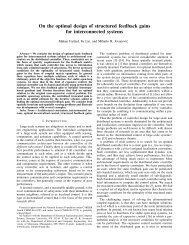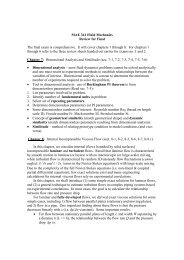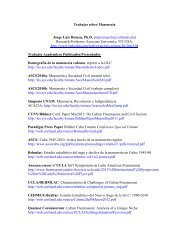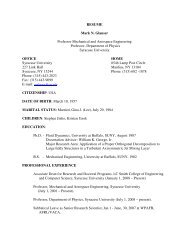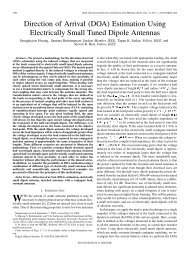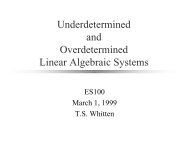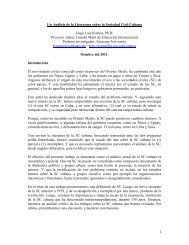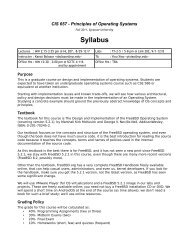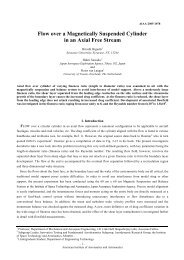Utilization of a Unitary Transform for Efficient Computation in the ...
Utilization of a Unitary Transform for Efficient Computation in the ...
Utilization of a Unitary Transform for Efficient Computation in the ...
You also want an ePaper? Increase the reach of your titles
YUMPU automatically turns print PDFs into web optimized ePapers that Google loves.
178 IEEE TRANSACTIONS ON ANTENNAS AND PROPAGATION, VOL. 54, NO. 1, JANUARY 2006<br />
Here, and are unitary matrices whose columns are <strong>the</strong><br />
eigenvectors <strong>of</strong> , and , respectively. is <strong>the</strong> s<strong>in</strong>gular<br />
values <strong>of</strong> , which are located on <strong>the</strong> ma<strong>in</strong> diagonals <strong>in</strong> <strong>the</strong> descend<strong>in</strong>g<br />
order<br />
. If <strong>the</strong> data is noiseless,<br />
<strong>the</strong> first s<strong>in</strong>gular values are nonzero, <strong>the</strong> rest is zero, where<br />
(29)<br />
(30)<br />
If <strong>the</strong> data is noisy, needs to be estimated, and how to do it<br />
is illustrated <strong>in</strong> [7]. The ratio <strong>of</strong> each <strong>of</strong> <strong>the</strong> s<strong>in</strong>gular value to <strong>the</strong><br />
largest one determ<strong>in</strong>es <strong>the</strong> value <strong>of</strong> . We choose<br />
, where is <strong>the</strong> number <strong>of</strong> accurate significant decimal<br />
digits <strong>of</strong> <strong>the</strong> data vector . One can rewrite <strong>the</strong> (25) as<br />
with<br />
S<strong>in</strong>ce,<br />
There<strong>for</strong>e<br />
(39)<br />
(40)<br />
(41)<br />
(42)<br />
where , and , with<br />
.<br />
The matrices , and are def<strong>in</strong>ed as follows:<br />
.<br />
.<br />
.<br />
. .. .<br />
.<br />
(31)<br />
. .. . .<br />
(32)<br />
For data contam<strong>in</strong>ated with noise, it is better to take <strong>the</strong><br />
SVD <strong>of</strong> so that some <strong>of</strong> <strong>the</strong> noise effect can be reduced.<br />
It can be shown that <strong>the</strong> s<strong>in</strong>gular vectors <strong>of</strong><br />
correspond to <strong>the</strong> signal space [9]. One can <strong>the</strong>n solve <strong>for</strong><br />
as <strong>the</strong> generalized eigenvalue <strong>of</strong> <strong>the</strong> matrix<br />
and , where, is <strong>the</strong><br />
largest s<strong>in</strong>gular vectors <strong>of</strong> . is estimated number <strong>of</strong> <strong>the</strong><br />
signals. That is, . Here, ,<br />
and are orthogonal matrices. is a diagonal matrix<br />
with its element . , such that<br />
<strong>the</strong> correspond<strong>in</strong>g s<strong>in</strong>gular values<br />
satisfy<br />
.Or<br />
is <strong>the</strong><br />
eigenvalue <strong>of</strong> .<br />
S<strong>in</strong>ce we do not know how many frequency components exist<br />
<strong>in</strong> <strong>the</strong> signal, <strong>the</strong> number <strong>of</strong> <strong>the</strong> estimated frequencies should<br />
be determ<strong>in</strong>ed us<strong>in</strong>g some criteria. Typically <strong>the</strong> s<strong>in</strong>gular values<br />
beyond are set equal to zero [7].<br />
.<br />
.<br />
.<br />
. .. . .<br />
(33)<br />
IV. SUMMARY OF THE ALGORITHM<br />
Basically <strong>the</strong> algorithm can be summarized as follows:<br />
From (31) and (33), one can write<br />
(34)<br />
(35)<br />
Note that , and is real from <strong>the</strong> <strong>the</strong>orems<br />
(1, 2, 3). There<strong>for</strong>e<br />
(36)<br />
It can be shown that , and<br />
, , and <strong>the</strong>re<strong>for</strong>e, (36) can<br />
be represented by<br />
(37)<br />
• Step 1: From <strong>the</strong> data vector ,<br />
f<strong>in</strong>d <strong>the</strong> MP from (2);<br />
• Step 2: Compute <strong>the</strong> real data matrix<br />
, us<strong>in</strong>g <strong>the</strong>orem (3);<br />
Or,<br />
from <strong>the</strong>orem (2);<br />
• Step 3: Evaluate and<br />
;<br />
• Step 4: Per<strong>for</strong>m a SVD <strong>of</strong> and<br />
calculate , which is <strong>the</strong><br />
largest s<strong>in</strong>gular vectors <strong>of</strong> ;<br />
• Step 5: Calculate <strong>the</strong> generalized<br />
eigenvalues<br />
<strong>of</strong><br />
and ;<br />
• Step 6: Calculate .<br />
.<br />
.<br />
Hence, (36) converts to<br />
(38)<br />
In this algorithm all computations are made us<strong>in</strong>g real numbers<br />
and <strong>the</strong>re<strong>for</strong>e, no variable is complex <strong>in</strong>clud<strong>in</strong>g <strong>the</strong> eigenvalues<br />
and <strong>the</strong> eigenvectors <strong>in</strong> this procedure.




